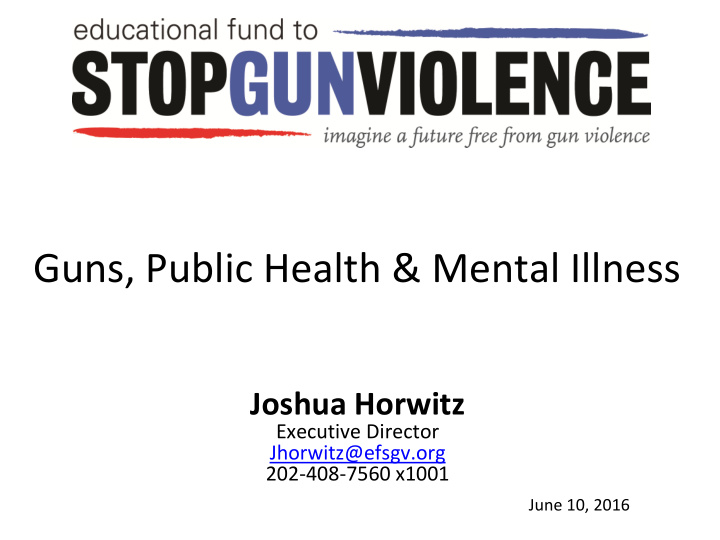



Guns, Public Health & Mental Illness Joshua Horwitz Executive Director Jhorwitz@efsgv.org 202-408-7560 x1001 June 10, 2016
US Firearm Deaths in 2014 Other/Undetermined 4% More than 33,000 gun deaths and Homicide 81,000 non-fatal 33% gunshot injuries Suicide per year 63% Source: CDC’s WISQARS™ (Web -based Injury Statistics Query and Reporting System). Fatal Injury Reports, 1999- 2 2014, for National, Regional, and States; Nonfatal Injury Reports, 2001 - 2014
Age-adjusted Firearm Death Rate: United States 14. Age-adjusted Firearm Death Rate per 100,000 10.5 7. 3.5 0. 2005 2006 2007 2008 2009 2010 2011 2012 2013 2014 Year US Suicide US Homicide US All Intents 3 Source: CDC’s WISQARS™ (Web -based Injury Statistics Query and Reporting System). Fatal Injury Reports, 1999-2014, for National, Regional, and States
Legal Context: Supreme Court recognizes legal right to a gun in the home for self defense But that right is not unlimited. Who can exercise the right safely? 4
Federal Prohibitors : • Felons; fugitives • Persons who have been involuntarily committed to a mental institution • Those convicted of a misdemeanor crime of domestic violence • Those subject to permanent domestic violence restraining orders • Unlawful users or those addicted to a controlled substance 5
Who should be prohibited from purchasing and possessing firearms? Can evidence help us do a better job identifying risk?
I Turned to the Experts … March 2013: Convened at Johns Hopkins Bloomberg School of Public Health, Baltimore MD • Public Health Researchers • Mental Health Providers • Medical Professionals • Gun Violence Prevention Advocates • Policy Experts • Law Enforcement Recommendat Evidence Consensus ions 8
Consortium for Risk-Based Firearm Policy Amy Barnhorst Garen Wintemute Richard Bonnie Jeff Swanson Shannon Frattaroli UC Davis Emergency UC Davis Duke University, University of Johns Hopkins Medicine, Violence Psychiatry and Virginia School of School of Medicine Bloomberg School of Prevention Research Behavioral Law Public Health Program Sciences Daniel Webster Renee Binder Beth McGinty Paul Appelbaum Johns Hopkins University of California, Columbia University Johns Hopkins Bloomberg School of School of Medicine San Francisco, School Bloomberg School of 9 Public Health of Medicine Public Health
Serious mental illness, on its own, contributes very little to overall violence towards others (a bigger risk factor for suicide) Attributable Risk of Minor or Serious Violent Behavior Towards Others: 96% of violence occurs due to reasons other 4% than serious mental illness alone 96% Other Risk Factors Serious Mental Illness 10
There are certain times, in certain settings, when those with a serious mental illness are at increased risk of violence Percent Violent Within 6 – 12 Months 37% 40% 36% 30% 23% 20% 8% 10% 2% 0% General Outpatients in Emergency Involuntarily First-episode population treatment departments committed psychosis without mental inpatients patients illness 11
Significant Risk Factors for Dangerousness Age (Young) Alcohol abuse Male Drug abuse Low socioeconomic History of violence Serious mental illness status Note, some of these risk factors cannot constitutionally be used for gun prohibitions 12
Predicted Probability of Violence in a One-year Period: Data From a Three City Study (Swanson, 1990) • Younger 65 % violent • Male • CUMULATIVE VIOLENCE RISK Lower SES Violence risk is multi- • factorial and cumulative: Serious mental illness Risk linked to mental illness • Substance abuse is embedded in other • History of psychiatric factors hospitalization • History of arrest • Older • Female • Middle to upper SES • No serious mental illness • No substance abuse • No psychiatric hospitalization • No arrest history <1 % violent 13
Population Attributable Risk of Suicide 47-74% of violence toward self attributable to mental illness alone Other factors Mental 26% Illness 47% - 74% Serious mental illness, on its own, contributes significantly to suicide
Gun Ownership & Suicide • Access to firearms is correlated with the risk of suicide. • Case-control studies in the US have found that the presence of a firearm is a strong risk factor for suicide .
Restricting firearm access on the basis of certain dangerous behaviors is supported by the evidence ; restricting access on the basis of mental illness diagnoses is not .
A new tool to help individuals in crisis • Gun Violence Restraining Order (GVRO) – Temporarily removes firearms from individuals who pose an immediate threat of harm to self or others – Based on Domestic Violence Restraining Order – Enables law enforcement and families to intervene when individuals are exhibiting dangerous behavior
Governor Brown Signing the Bill 18
CA GVRO – Factors Courts Must Consider • A recent threat of violence or act of violence by the subject of the petition directed toward another, or himself or herself • A recent violation of a protective order of any kind • A conviction of a violent offense • Mental health diagnosis is NOT a factor 19
A gun-safety group announced Thursday it is going back to voters after Washington state lawmakers failed to pass a bill creating extreme-risk protection orders that take guns from people who pose a serious risk of hurting themselves or others.
Discussion Joshua Horwitz Executive Director Jhorwitz@efsgv.org 202-408-7560 x1001 21
Recommend
More recommend